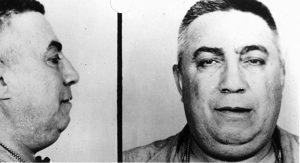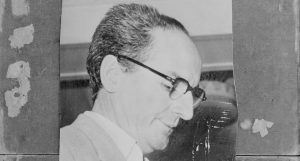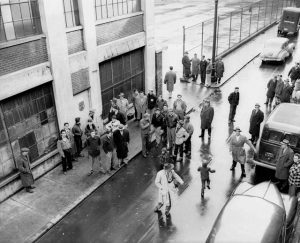For a long time, the armed heist known as the Brink’s Holdup was the most successful robbery in United States history. It took place in Boston’s North End on 165 Prince Street at the headquarters of Brink’s Incorporated on January 17, 1950. The job was meticulously planned and brilliantly executed, and the thieves made off with over $2 million. The robbers were local heroes; Boston for some reason has a longstanding love affair with bank robberies. Because the story of the heist is not generally known to younger readers, we will relate it here.
The idea for the robbery began in the mind of a North End tough guy named Tony “Fats” Pino. He put the Brink’s company on Prince Street under observation, knowing that it dealt on a daily basis with large amounts of cash and bonds as part of its payroll operations in the local area. Plans began to form slowly in his mind. From rooftops and overlooking rooms nearby, his sharp senses noticed that the Brink’s employees would often let their guards down when dealing with large amount of cash. He was convinced that a successful heist was possible. But it would be difficult, and would need a disciplined team with precision timing.

Anthony “Fats” Pino
The next step was to recruit a first-rate crew. To this end Pino turned to two underworld chums he knew well: Stan “Gus” Gusciora and Joseph “Specs” O’Keefe. Both had come from the Boston streets and were true professionals at their trade. Gusciora was good with the muscle, and O’Keefe was known to be a calm, calculating, and highly intelligent thief. Together they would plan and stage the greatest robbery in US history.
Various plans were discussed. One scheme had the robbers hide in the building and overpower the employees in the morning; another idea was to take the head foreman hostage and make him open up the cash vault. O’Keefe thought that there must be a better way. So he and Gus eventually figured out how to enter the Brink’s building at night through an abandoned garage; once in, they performed a thorough reconnaissance of the cash house itself. The key to a successful robbery, they realized, would be to disable the Brink’s alarm system, which was only set at around seven o’clock each night.
From these preparations, O’Keefe hit on the idea of removing the lock cylinders from all the doors leading to the cash vault itself. He thought it would be possible to remove the lock cylinders, have keys cut for the locks, and then replace the cylinders in the various doors without anyone noticing. If they could do this, then they could enter the building during the day without triggering the alarm.
From this point the general plan took shape. Seven men would enter the building using the duplicate keys. They would disable the employees in the vault and take all the moveable cash. Drivers would wait in a getaway vehicle outside. Another man would meet the team at a safehouse after the getaway to divide the loot. The crooks found a way to get uniforms that looked just like the ones worn by Brink’s employees. The jump-off date for the operation was set for January 17, 1950.

Joseph “Specs” O’Keefe
At 165 Prince Street, O’Keefe and his men entered the Brink’s building armed with pistols, rope, bags, and duct tape. They put on Halloween masks and headed straight for the vault. Going right up to the shocked employees, they pulled out guns and told everyone to shut up or else. A couple workers were picked out to accompany the bandits to the vault, and there they filled multiple bags with cash. In about twenty minutes, it was all over. The crew left the building laden with loot and drove away, leaving the stunned employees to try to figure out how it had all happened. Each member of the crew received about $100,000 as his take in the haul.
When news of the robbery leaked out, Boston Police Superintendent Edward Fallon summoned over 150 law enforcement men to police headquarters to brief them on what had happened. Meanwhile, the public’s imagination was captivated by the daring robbery. The crooks had gotten off scot-free, it seemed; there were few leads and no real clues, and soon the story faded from public attention.

The Brink’s building on Prince Street after the heist
But as often happens, the thieves would prove to be the source of their own undoing. Greed, jealousy, and suspicion would doom them all. Specs O’Keefe and Stan Gusciora would eventually be arrested for unrelated crimes and ended up doing time in Pennsylvania; while they were away, “friends” spent their stolen loot. The police did eventually discover parts of the getaway car at a junkyard; the hold-up men had tried to bury its parts, but the frozen ground prevented this. Not much else was forthcoming, and the three-year statute of limitations on prosecutions loomed for the FBI. Unless a break in the case was found, they would never be able to do anything, even if they caught some suspects.
When O’Keefe got out of jail and found out that his friends had spent all his money, he was furious. In a long series of machinations too convoluted for us to follow here, O’Keefe took increasingly desperate measures to try to recover his money from other members of the gang. Soon violence came into the picture, and Specs narrowly missed an attempt to kill him. He had been wounded, and this provided FBI agents an opportunity to try to turn him against his former comrades. They made a point of telling him how most of the former gang members had grown rich, while he himself had nothing to show for masterminding the Brink’s job.
Slowly, O’Keefe’s hardened exterior began to crack. Seething with anger at having been used and cast aside, he agreed to spill his guts to the FBI. He revealed the names of all the participants in the Brink’s job, and described in detail how he pulled it off. With this precious information, prosecutors brought indictments against all the surviving gang members (two had since died). When the trial was held in Boston in 1956, they got life in prison.
Specs was given special consideration for his role in solving the crime. Law enforcement frankly admitted that without his cooperation, the crime never would have been solved. He was paroled in 1960 with a name change, and died quietly sixteen years later. Most of the loot from the Brink’s job was never recovered. While a perfect accounting is impossible, it is accurate to say that about $1 million in untraceable loose cash was hidden from the robbery, and has never been found.
Read More: What The Future Of News Will Look Like
“He had been wounded, and this provided FBI agents an opportunity to try to turn him against his former comrades.”
How did the FBI know he had something to do with the heist?
FBi like any federal agency gets involved when the case crosses the boundary of the county/state.
So?
Whitey Bulger told them.
Poop article
Yeah, Kratom is banned so article quality is dropping off. Sad.
The ban has been postponed for now, haven’t you heard?
that feel when the kratom is delayed…
Yes…I can always admire a good robbery well executed…Khardashian springs to mind.
That was a publicity stunt.
So…there was no police involvement then?
And apparently no video, etc.
Look, one of the fatass’s bodyguards took out some media clown who tried to sneak up on her and literally kiss her ass for a stunt.
So where were they (and hotel security) when she was bound, gagged, and sexually used until she came for hours, and then she paid them for their services with some jewelry?
The Police seem to have been called, interviewed people etc. If it is a hoax they’re gonna be pissed off(and it’s a criminal offence)…but never mind. Plenty of others to admire.
I always wanted to rob a bank but never found accomplices.
Here, here!
“It was between the Italians. Real greaseball shit”
“And there was nothing we could do about it.”
Now go home and get your fuckin shine box.
“And that’s that”
“You flushed it down the toilet? Why did you do that KAH-rinnn?”
“He’s not Jewish. You know how those people live?”
It’s been one year since I resigned from my last job and I never felt so good in my life… I started working from my house, over a website I stumbled upon over internet, several hrs /a day, and my income now is much bigger then it was on my office job… My last month payment was for 9000 dollars… Amazing thing about this is that now i have more time with my kids… http://chilp.it/728813e
Go get your fuckin shine box.
Unconscionable ball breaker.
I ordered some spaghetti and marinara sauce, I got egg noodles and ketchup…. I’m an average nobody… Get to live the rest of my life like a schnook.
Hey, Ma. I settle down with a nice girl every night and then I’m free the next morning.
Hey! Here’s a leg! Here’s a wing!
Yeah, Nunzio up in blehhhh!
Thought he’d never shut the fuck up.
Spider you’re a fuckin mumblin, stutterin, little fuck. You know that?!
What you want me to do? Shoot ’em?
That wouldn’t be a bad idea.
8 |
I have this theory that the mafia only thrived in cities with strict gun control. We know that the NY, Chicago, Boston, LA, Detroit of today are gun control zones. Was this so back in the 1920’s as well? I can’t see how gun owning men could sit back and allow degenerates to get away with half the things they did.
Not really, no. I think that a lot of the gun control crap started because of it though. I don’t know about NYC, but most of the big time bank robbers hit the Midwest or came from here. The mob was actually pretty adamant about not doing too many shootouts in public, out of fear that the public (armed) would start souring on them and then take them out. Or so I’ve heard.
I have a great uncle who was a bank robber in one of the rust belt states. He was a total professional. Never harmed anyone and robbed more banks than dillinger.
He also escaped from prison.
A man’s man!
If he’s still alive, I’d be honored to shake his hand.
Never harmed anyone except in their pocketbooks and thus their livelihoods.
Robbing banks doesn’t harm anyone except some Jews.
Inconveniences their culture mandated inferiority complex.
“I’m gawnna get those whytees. Next one I see, I’m gawnna take his money more this time!”
When you pay taxes you aid in further harm to the productive class through redistribution of wealth.
Get the fuck off that high horse.
This might come as a shock to you but people who aren’t Jews put their money into banks.
truth.
No. They thrived/thrive in a variety of locales.
Crime will thrive anywhere there is human greed. Which is basically everywhere in the world.
Or where people want sex, drugs, and violence. Which is also everywhere in the world.
$2 million in 1950 would be close to at least $20 million today.
http://www.usinflationcalculator.com/
while they were away, “friends” spent their stolen loot.
Reminded me of this scene.
You gotta admire the balls these guys had. Sincerely.